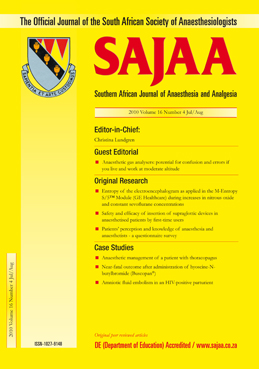Patients’ perception and knowledge of anaesthesia and anaesthetists – a questionnaire survey
Keywords:
Patients’ perception, Anaesthetists’ role, knowledge, surveyAbstract
Background: Most surgical patients do not recognise the role played by anaesthetists in the perioperative period because of poor public knowledge of anaesthesia as a medical discipline. This study was conducted to determine patients’ knowledge of anaesthesia and of the qualifications and role of anaesthetists in patient care. Methods: A cross-sectional questionnaire survey of 229 consecutive adult patients aged 18 years and above, scheduled for elective surgery at the University College Hospital, Ibadan, Nigeria, was conducted over a threemonth period. Results: Of the 229 patients studied, 90 (39.3%) were males and 139 (60.7%) were females. Ninety-nine (43.2%) had a history of previous anaesthesia and surgery, while 130 (56.8%) had no previous experience of anaesthesia. One-third (33 of 99) of patients who had past experience of anaesthesia knew that anaesthesia is administered by qualified anaesthetists. Among 130 patients without a history of previous anaesthetics, 63 (48.5%) had no idea of what the role of the anaesthetist was, 31 (23.8%) listed putting patients to sleep, monitoring vital signs and offering pain relief, and 25 (19.2%) knew that anaesthetists should administer anaesthetics. Patients who had tertiary education (44.1%) had a significantly higher knowledge of the anaesthetist’s role than those with only secondary (33.2%) or primary education (15.7%, p < 0.05). Conclusion: Patients have poor knowledge of anaesthesia and the role of anaesthetists in the care of surgical patients. This knowledge deficit should be addressed and made part of the general preoperative care to enable patients to cope better with a view to improving the outcome of surgical procedures.Downloads
Additional Files
Published
Issue
Section
License
By submitting manuscripts to SAJAA, authors of original articles are assigning copyright to the SA Society of Anaesthesiologists. Authors may use their own work after publication without written permission, provided they acknowledge the original source. Individuals and academic institutions may freely copy and distribute articles published in SAJAA for educational and research purposes without obtaining permission.
The work is licensed under a Creative Commons Attribution-Non-Commercial Works 4.0 South Africa License. The SAJAA does not hold itself responsible for statements made by the authors.

